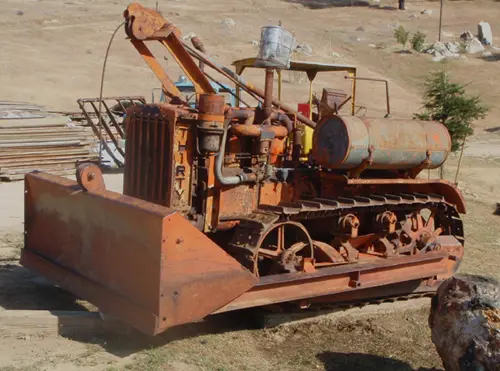That's a nice tractor and blade setup, and is a real classic. Don't have anything much on William Bros .. except that I can tell you, that the "Bros" wasn't an abbreviation of "brothers", as you'd normally presume .. but the name of the company was actually, "William Bros", with the surname of Bros .. they were in business for a long time, but appear to have been more closely associated with railroad production.
Perhaps the severe downtrend in steam in the 1930's sent them over to construction attachment building.
There is no mention of them in my 156 page, 1929 "Dotted Line" catalog, which lists every supplier of attachments for Cats, under company names, as well as under products.
The original wooden factory for "William Bros Boiler & Mfg" was built on Nicollet Island, MN, in 1886 and burnt down in 1893. A new brick building replaced it. This building still stands, and is now the Nicollet Island Pavilion .. this following guide still errs in calling the company "William Brothers".
http://fieldguide.fmr.org/site_detail.php?site_id=120
http://www.mintahoe.com/index.cfm?objectid=69AC6B76-1372-537E-D58CA5AD9A53B7F9
William Bros Boiler Mfg changed its name to "Bros Incorporated" in the 1950's, and there are numerous lawsuits listed on the 'net involving both company names. It's difficult doing a Google search, because a search always presumes you are looking for "brothers", and not "Bros".
I seem to recall that several States in the late 1920's, ordered Cats in specified bright colors, to make them more visible in poor light on highway construction projects, to reduce the number of auto accidents involving cars and trucks running into parked equipment. This was apparently one of the driving factors behind the change to highway yellow .. besides the marketing people stating that they needed a bright color to lift peoples spirits at the lowest point of the Great Depression.
In 1931, Missouri was already specifying Silver color on all county orders, and Kansas was specifying a particular Orange color. Hi-Way Yellow was chosen ..
"after full consideration of every factor - attractiveness of appearance, the safety factor of high visibility use, the legal requirements in certain localities for machines used on the highways, durability of paint, and protection of the surface" ..
It is not widely known, that the final paragraph of the inter-office memo issued in early December 1931, read ..
"Road machines can be supplied in colors other than Hi-Way Yellow, at the extra cost shown in the current price list. Unless your orders specify otherwise, you will be supplied with tractors and road machines of the above color, hereafter. Purchasers of tractors, will now also have the option, at no extra cost, of Silver Gray, trimmed in black - a lighter, brighter, and more attractive shade of gray than has been standard in the past. However, if this color is desired, your orders must so specify - otherwise tractors will be painted Hi-Way Yellow. The present Gray, and any other colors other than Hi-Way Yellow and Silver Gray, may be had at the extra charge shown in the current price list".

